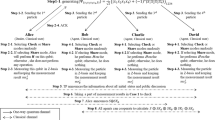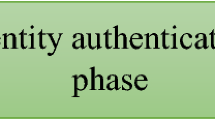Abstract
Two multiparty simultaneous quantum identity authentication (MSQIA) protocols based on secret sharing are presented. All the users can be authenticated by a trusted third party (TTP) simultaneously. In the first protocol, the TTP shares a random key K with all the users using quantum secret sharing. The ith share acts as the authentication key of the ith user. When it is necessary to perform MSQIA, the TTP generates a random number R secretly and sends a sequence of single photons encoded with K and R to all the users. According to his share, each user performs the corresponding unitary operations on the single photon sequence sequentially. At last, the TTP can judge whether the impersonator exists. The second protocol is a modified version with a circular structure. The two protocols can be efficiently used for MSQIA in a network. They are feasible with current technology.
Similar content being viewed by others
References
Bennett C H, Brassard G. Quantum cryptography: Public-key distribution and coin tossing. In: Proceedings of the IEEE International Conference on Computers, Systems and Signal Processing. New York: IEEE, 1984. 175–179
Ekert A. Quantum cryptography based on Bell’s theorem. Phys Rev Lett, 1991, 67: 661–664
Bennett C H. Quantum cryptography using any two nonorthogonal states. Phys Rev Lett, 1992, 68: 3121–3124
Deng F G, Long G L. Bidirectional quantum key distribution protocol with practical faint laser pulses. Phys Rev A, 2004, 70: 012311-1–4
Deng F G, Long G L. Controlled order rearrangement encryption for quantum key distribution. Phys Rev A, 2003, 68: 042315-1–5
Wang J, Zhang Q, Tang C J. Quantum secure direct communication based on order rearrangement of single photons. Phys Lett A, 2006, 358: 256–258
Li X H, Deng F G, Li C Y, et al. Deterministic secure quantum communication without maximally entangled states. J Korean Phys Soc, 2006, 49: 1354–1359
Deng F G, Long G L, Liu X S. Two-step quantum direct communication protocol using the Einstein-Podolsky-Rosen pair block. Phys Rev A, 2003, 68: 042317-1–4
Deng F G, Long G L. Secure direct communication with a quantum one-time pad. Phys Rev A, 2004, 69: 052319-1–4
Cai Q Y, Li B W. Deterministic secure communication without using entanglement. Chin Phys Lett, 2004, 21: 601–603
Zhu A D, Yia Y, Fan Q B, et al. Secure direct communication based on secret transmitting order of particles. Phys Rev A, 2006, 73: 022338-1–4
Cao H J, Song H S. Quantum secure direct communication with W state. Chin Phys Lett, 2006, 23: 290–292
Li X H, Zhou P, Liang Y J, et al. Quantum secure direct communication network with two-step protocol. Chin Phys Lett, 2006, 23: 1080–1083
Wang C, Deng F G, Li Y S, et al. Quantum secure direct communication with high-dimension quantum superdense coding. Phys Rev A, 2005, 71: 044305-1–4
Hillery M, Bužek V, Berthiaume A. Quantum secret sharing. Phys Rev A, 1999, 59: 1829–1834
Karlsson A, Koashi M, Imoto N. Quantum entanglement for secret sharing and secret splitting. Phys Rev A, 1999, 59: 162–168
Deng F G, Zhou H Y, Long G L. Circular quantum secret sharing. J Phys A: Math Gen, 2006, 39: 14089–14099
Cleve R, Gottesman D, Lo H K. How to share a quantum secret. Phys Rev Lett, 1999, 83: 648–651
Deng F G, Zhou H Y, Long G L. Bidirectional quantum secret sharing and secret splitting with polarized single photons. Phys Lett A, 2005, 337: 329–334
Guo G P, Guo G C. Quantum secret sharing without entanglement. Phys Lett A, 2003, 310: 247–251
Zhang Z J, Man Z X. Multiparty quantum secret sharing of classical messages based on entanglement swapping. Phys Rev A, 2005, 72: 022303-1–4
Zhang Z J, Li Y, Man Z X. Multiparty quantum secret sharing. Phys Rev A, 2005, 71: 044301-1–4
Deng F G, Li X H, Li C Y, et al. Multiparty quantum-state sharing of an arbitrary two-particle state with Einstein-Podolsky-Rosen pairs. Phys Rev A, 2005, 72: 044301-1–4
Deng F G, Li C Y, Li Y S, et al. Symmetric multiparty-controlled teleportation of an arbitrary two-particle entanglement. Phys Rev A, 2005, 72: 022338-1–8
Yan F L, Gao T. Quantum secret sharing between multiparty and multiparty without entanglement. Phys Rev A, 2005, 72: 012304-1–5
Dušek M, Haderka O, Hendrych M, et al. Quantum identification system. Phys Rev A, 1999, 60: 149–156
Curty M, Santos D J. Quantum authentication of classical messages. Phys Rev A, 2001, 64: 062309-1–6
Mihara T. Quantum identification schemes with entanglements. Phys Rev A, 2002, 65: 05236-1–4
Zeng G H, Zhang W P. Identity verification in quantum key distribution. Phys Rev A, 2001, 61: 022303-1–5
Ljunggren D, Bourennane M, Karlsson A. Authority-based user authentication in quantum key distribution. Phys Rev A, 2000, 62: 022305-1–7
Zhou N R, Zeng G H, Zeng W J, et al. Cross-center quantum identification scheme based on teleportation and entanglement swapping. Opt Commun, 2005, 254: 380–388
Wang J, Zhang Q, Tang C J. Multiparty simultaneous quantum identity authentication based on entanglement swapping. arXiv: quant-ph/0605006
Bouwmeester D, Pan J W, Daniell M, et al. Observation of three-photon greenberger-horne-zeilinger entanglement. Phys Rev Lett, 1999, 82: 1345–1349
Pan J W, Daniell M, Gasparoni S, et al. Experimental demonstration of four-photon entanglement and high-fidelity teleportation. Phys Rev Lett, 2001, 86: 4435-1–4
Gottesman D. Theory of quantum secret sharing. Phys Rev A, 2000, 61: 042311-1–8
Cai Q Y. Eavesdropping on the two-way quantum communication protocols with invisible photons. Phys Lett A, 2006, 351: 23–25
Deng F G, Li X H, Zhou H Y, et al. Improving the security of multiparty quantum secret sharing against Trojan horse attack. Phys Rev A, 2005, 72: 044302-1–3
Qin S J, Gao F, Wen Q Y, et al. Improving the security of multiparty quantum secret sharing against an attack with a fake signal. Phys Lett A, 2006, 357: 101–103
Author information
Authors and Affiliations
Corresponding author
Additional information
Supported by the National Basic Research Program of China (973 Program) (Grant No. 2007CB311100), the National High Technology Research and Development Program of China (Grant Nos. 2006AA01Z419 and 20060101Z4015), the Major Research Plan of the National Natural Science Foundation of China (Grant No. 90604023), the Scientific Research Common Program of Beijing Municipal Commission of Education (Grant No. KM200810005004), the Scientific Research Foundation for the Youth of Beijing University of Technology (Grant No. 97007016200701), the National Research Foundation for the Doctoral Program of Higher Education of China (Grant No. 20040013007), the National Laboratory for Modern Communications Science Foundation of China (Grant No. 9140C1101010601), and the Doctor Scientific Research Activation Foundation of Beijing University of Technology (Grant No. 52007016200702)
Rights and permissions
About this article
Cite this article
Yang, Y., Wen, Q. & Zhang, X. Multiparty simultaneous quantum identity authentication with secret sharing. Sci. China Ser. G-Phys. Mech. As 51, 321–327 (2008). https://doi.org/10.1007/s11433-008-0034-5
Received:
Accepted:
Published:
Issue Date:
DOI: https://doi.org/10.1007/s11433-008-0034-5




